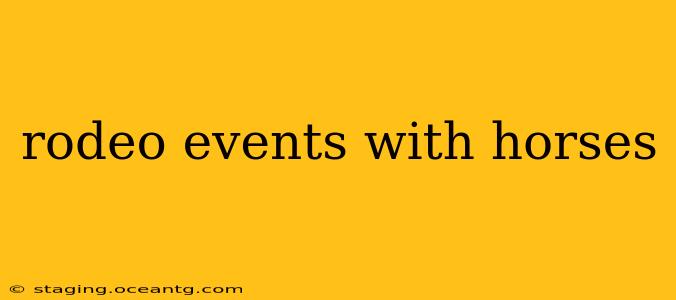Rodeos are thrilling spectacles of skill, athleticism, and tradition, and a significant portion of the excitement comes from the equestrian events. These events showcase the incredible bond between horse and rider, demanding years of dedicated training and practice to master. This comprehensive guide delves into the most popular rodeo events featuring horses, providing insights into their unique challenges and the athleticism required.
What are the Main Horse Events in a Rodeo?
The main horse events in a rodeo typically include:
-
Bareback Bronc Riding: This event tests the rider's skill in staying atop a bucking bronco for eight seconds without using a saddle. The rider uses only their legs and core strength to maintain balance.
-
Saddle Bronc Riding: Similar to bareback bronc riding, but the rider utilizes a specialized saddle with a bronc string (a leather strap used for added grip). This event still demands exceptional strength, balance, and nerve.
-
Bull Riding: While technically not a horse event, it's crucial to mention bull riding as it's a staple of most rodeos and closely related in terms of the raw athleticism and danger involved. Riders attempt to stay on a bucking bull for eight seconds, utilizing only one hand to grip a braided rope.
-
Steer Wrestling: This event involves a team of two cowboys, one riding a horse and the other attempting to wrestle a steer to the ground. This requires precise timing, coordination, and significant strength from both the horse and the wrestlers.
What are Some Less Common Rodeo Events with Horses?
While the events above are the most common, some rodeos also feature these less frequent, but equally impressive, equestrian competitions:
-
Team Roping: Two cowboys on horseback work together to rope a steer. One cowboy ropes the steer's horns, while the other ropes its hind legs. This requires exceptional coordination and teamwork.
-
Barrel Racing: This event is exclusively for women and features a horse and rider racing around three barrels in a cloverleaf pattern. Speed and precision are crucial, showcasing both the horse's agility and the rider's skill.
What is the Difference Between Bareback and Saddle Bronc Riding?
The primary difference lies in the equipment used. Bareback bronc riding requires the rider to stay on the horse using only their legs and core strength, enhancing the difficulty and danger. Saddle bronc riding allows the use of a specialized saddle and a bronc string, giving the rider some added grip and leverage, but the horse still bucks fiercely, requiring incredible balance and strength.
What Makes a Good Rodeo Horse?
A good rodeo horse possesses a combination of crucial qualities:
-
Athleticism: Exceptional strength, agility, and stamina are paramount. They need to withstand intense bucking and spinning movements.
-
Temperament: A calm demeanor during the preparation phase is crucial, while demonstrating explosive energy and bucking ability during the ride is essential.
-
Training: Years of specialized training are necessary to develop the horse's bucking style and responsiveness.
-
Soundness: A rodeo horse must be physically sound to withstand the rigorous demands of the events.
How are Rodeo Horses Trained?
Rodeo horse training is a complex and lengthy process that varies depending on the event. It often involves a combination of techniques to develop their bucking ability while ensuring their safety and the safety of the rider. Experienced trainers carefully cultivate the horse's natural instincts and athleticism through a specialized training regimen. This often involves using various stimuli and techniques to condition them for the intense ride. Ethical treatment and animal welfare are paramount in this process.
What are the Risks Involved in Rodeo Horse Events?
Rodeo events with horses involve significant risk for both the horse and the rider. Injuries are possible, ranging from minor bruises to serious fractures and concussions. The unpredictable nature of the animals and the high-impact movements inherent in these events contribute to the inherent danger.
This guide offers a comprehensive overview of rodeo events with horses. While each event showcases unique challenges, all demonstrate the remarkable athleticism, skill, and bond between horse and rider. The excitement and tradition surrounding these events continue to captivate audiences worldwide.
